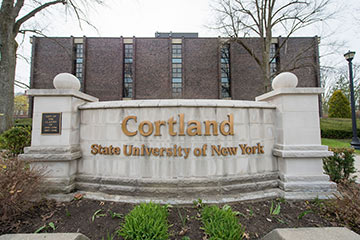
08/14/2020
The following message was sent to the SUNY Cortland community on behalf of President Erik J. Bitterbaum:
To the SUNY Cortland community,
As our students have been completing the online 14-day pre-screen required to come to campus, many members of our community have had questions about why SUNY Cortland chose this method to prevent COVID-19 from establishing an early foothold in Cortland. That is understandable. Colleges and universities across the state, and within the SUNY system, have implemented a wide variety of screening, testing and monitoring plans. These range from required COVID-19 testing for all returning students to more targeted testing strategies like those adopted by Cortland, University of Buffalo , SUNY Plattsburg and other institutions. Because research on this virus is so new, legitimate articles and studies supporting all methods can readily be found.
SUNY Cortland’s plan, developed in collaboration with medical and health professionals, is supported by evidence, approved by New York state and based on guidelines for higher education institutions from the Centers for Disease Control and the American College Health Association. No current testing plan is perfect, but we have determined that screening students, faculty and staff for risk factors and testing only those likely to be infected is the most realistic and practical way to keep our community safe. Consider the following points:
- Testing all students 14 days before campus arrival and screening all students 14 days before arrival has a very similar outcome. Students who test positive isolate for 14 days. Students who test negative simply arrive on campus in 14 days. Similarly, students who screen positive through SUNY Cortland’s system begin a 14-day precautionary quarantine. Students who screen negative arrive on campus in 14 days.
- Requiring tests closer to the start of classes might have some marginal benefit, but testing delays and logistical barriers would likely prevent SUNY Cortland from receiving results in time to take effective action, rendering the results nearly meaningless.
- One-time testing will miss the early stages of infection, and false negative results may give students a false sense of security that influences behavior. The only way to keep false negatives from enabling COVID-19 transmission would be to couple testing with universal quarantine, regardless of test results.
- In areas like Cortland County, which has a low prevalence of the disease, mass testing of asymptomatic students is more likely to result in a significant number of false positives. Each false positive patient would require isolation, contact tracing and quarantine of all people who might be at risk, creating a significant and unnecessary drain on resources.
Once students arrive on campus, they will electronically sign their agreement to follow all COVID-19 prevention guidelines and begin taking a daily, online screening survey. Should a student indicate symptoms or likely exposure to the virus, Student Health Services will administer diagnostic testing and send samples to a local lab with the expectation we will receive results within a few days. Because we are efficiently targeting the use of these tests through screening, SUNY Cortland is able to absorb the cost to students. Many institutions that require broader testing are passing the significant cost of those tests on to their students, which – as a public institution that knows its students and their families have been hard hit by the recession – we do not want to do.
As I discussed in last week’s update, we have submitted to SUNY system our plan for college fee waivers and possible refunds should an outbreak of COVID-19 force us to shift to remote instruction before the fall semester ends. Although we had hoped to have that information posted on our website this week, we are still awaiting final approval.
Like most of our students and their families, SUNY Cortland’s administrators have been closely following discussions related to a possible federal stimulus package to help with steep budget shortfalls caused by the economic recession. This week, Senate Minority Leader Chuck Schumer, who is playing a leading role in negotiations, visited me and Provost Mark Prus on campus to discuss our coronavirus response and our needs. He shared that the $3 trillion plan supported by Democratic lawmakers includes $132 billion to help higher education and college students. We are hopeful, but a compromise with the $1 trillion stimulus plan put forth by Republican legislators does not seem imminent.
Finally, I’d like to remind all of you that this will be a semester of increased personal responsibility for all of us. We can teach, learn, socialize, have fun and experience new things under the shadow of the pandemic, but our ability to do so successfully rests on the commitment that each of us has to preventing the spread of the novel coronavirus. It is a commitment that is shared across the entire 64-campus SUNY system, and at its core are but a handful of simple things outlined in this short, SUNY video.
As a reminder, if students have not already done their 14-day pre-arrival screen, they should consider doing it very soon. Classes begin in 17 days and students will begin moving into campus residences next weekend. Students cannot come to campus until this is done. Think of it as the first step of a semester-long commitment against COVID-19.
All the best,
Erik J. Bitterbaum